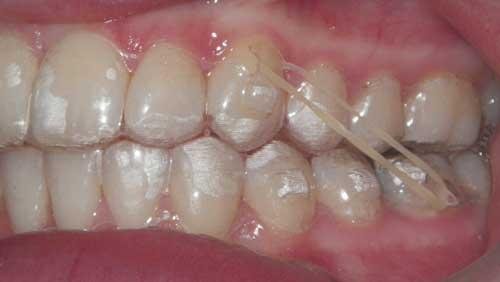ORTHODONTIC TIPS & TRICKS
How to fix a pokey wire with wax: How to fix a broken bracket with wax:
How to fix a spring out on bite jumpers:
In order to reduce the number of visits to the office, we are providing the following tips and tricks to help patients solve some of their orthodontic emergencies at home:
FOR PATIENTS IN BRACES
If you haven't been following the recommendations for taking care of your braces up to this point, now would be a great time to start. Do everything you can to prevent things from breaking so that you don't have to worry about what to do with a broken bracket or wire. That being said, your comfort is more important than the braces themselves. In general, if there is something you need to do to make yourself comfortable that includes removing or cutting something, we recommend doing it and having it fixed later.
Pokey wires or brackets with wax: Most pokey wires are small and can be made more comfortable by placing wax over the sharp part of the wire or bracket. Roll the wax into a small ball, dry the area to be covered as best you can before lightly pushing the wax into place. We have wax available at our offices for our patients. If you cannot get to one of our offices, wax can also be purchased online (Amazon.com) or from Rite Aid, Walgreens, or other pharmacies.
Broken brackets and long wires: Most brackets that break off of the teeth can be left off until your next appointment. However, sometimes losing a bracket means that a large section of wire is left to scratch and scrape the inside of your cheek. Any long wires can be cut by using nail clippers or wire cutting pliers. If you can see the wire to be cut and have enough room to access it, cut the wire and remove any loose pieces from the mouth.
Active springs: “Bitejumpers” and other springs placed along with the braces continue to be active over time. This means that with longer time periods between appointments they can move your teeth more than the desired amount. If you notice any unusual movements, call us.
Elastics: Elastics for braces are also known as rubber bands. If you run out of elastics or lose your bag, please give us a call or stop by one of our offices to get a new bag! Please do not share your elastics with friends or siblings!
Large sores, cuts or infections: If a cut or sore is being caused by a pokey wire as described above, it should resolve itself after following the steps above. We also recommend swishing around with a saltwater rinse. If it does not resolve or if you have a particularly large cut or sore please call us to set up an emergency appointment. True infections that you feel are being caused by orthodontic appliances should also be seen as soon as possible. Signs of infections can include swelling, pus, and redness. Dental infections that are not related to the orthodontic appliances should be seen by your general dentist
Unusual pain or discomfort: Most patients know that they can expect a certain amount of discomfort during orthodontic treatment. This discomfort can change in location and severity throughout their time in orthodontics. It is also important to note that during these times in particular most people will have a higher amount of stress which can lead to clenching and grinding, causing more pain in their teeth and jaws. However, if you have a severe and unusual amount of pain please call us.
FOR PATIENTS WITH EXPANDERS
Please call us if you are having any issues with your expander or other appliance.
FOR PATIENTS IN INVISALIGN
If you are on your last tray or need to wear a set of trays for longer than 2 weeks you can wear the trays at nights only, after wearing them for at least two weeks full time. This will help the trays last longer. We also recommend that you keep at least two of your most recently worn sets of trays just in case you lose or break a tray and have to go into an older tray. Also, please remember to wash your hands before removing and placing your trays!
Elastics: Unless you have been instructed otherwise or have been told that you will be in elastics for a long time, we recommend you wear your elastics only until the date of your next appointment, even if that appointment has been canceled. If anything has broken that prevents you from wearing the elastics then you will have to stop wearing them until we can see you again.
Broken attachments: Broken attachments may have to wait until your next appointment to fix, however, please call us if something breaks. If you notice that your trays are not fitting as well due to a broken attachment and you are unable to get into the office soon then we recommend slowing down your treatment by wearing each tray longer until we have a chance to fix the broken attachments.
Ill-fitting aligners: If your trays (aligners) are not fitting as well as they used to, we recommend wearing the trays longer and using "chewies" to help seat the trays better. Chewies are small rubbery cylinders that we typically give to patients when their trays need extra help fitting to the teeth. Once you place your trays you bite on the chewies to push the trays into your teeth. If you do not have chewies you can use a clean rolled up cloth instead.
Curb-side service: There are some Invisalign patients who will be able to pick up more trays without having to come into the office. It is important to understand that this does not apply to every Invisalign patient as some patients are due to have attachments placed or other modifications done before more trays can be delivered. If you are in need of more trays and want to find out if you can have more trays given to you curbside, please call our office.
FOR PATIENTS IN RETAINERS
Please call us if you have a broken or lost retainer.


